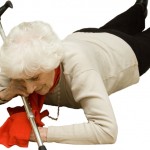
Prevention of falls is a major public health issue and this has been given focused attention by AGILE: UK Chartered Physiotherapists working with Older People. AGILE launched their new ‘Guidelines for the Physiotherapy management of older people at risk of falling’ at the World Congress of Active Ageing in Glasgow last week.
The document focusses on the key aims of; preventing falls; improving older people’s ability to withstand threats to their balance; preventing the consequences of a long life, and optimising confidence and reducing fear of falling. The authors provide key messages under each of these aims.
They also recommend exercise programmes, which should have a high balance challenge component, and be delivered at a high ‘dose’ of 50 hours – roughly twice a week for six months.
Here are their practice points
- Establish the extent to which older people and their carers are able to participate in a falls prevention programme.
- Use appropriate outcome measures
- Use patient goal setting (as opposed to therapy goals)
- Employ strategies for motivation and adherence
- Consider supplementary interventions for those at risk of fragility fracture
- Provision of mobility aids should be part of a broader rehabilitation programme
- Clinical decisions should be based upon the best available evidence.
The Musculoskeletal Elf’s views
 These are the first physiotherapy focussed guidelines on falls prevention. The exercise programmes recommended are those with a high balance challenge component and considerations should be given to those at risk of fragility fracture. Coincidentally these are the subjects of Cochrane Reviews by The Musculoskeletal Elf; ‘Exercise for improving balance in older people‘ and ‘Exercise for preventing and treating osteoporosis in postmenopausal women‘. We also look forward to the updates of the Cochrane reviews on ‘Interventions for preventing falls in older people living in the community‘ and ‘Interventions for preventing falls in older people in nursing care facilities and hospitals‘
These are the first physiotherapy focussed guidelines on falls prevention. The exercise programmes recommended are those with a high balance challenge component and considerations should be given to those at risk of fragility fracture. Coincidentally these are the subjects of Cochrane Reviews by The Musculoskeletal Elf; ‘Exercise for improving balance in older people‘ and ‘Exercise for preventing and treating osteoporosis in postmenopausal women‘. We also look forward to the updates of the Cochrane reviews on ‘Interventions for preventing falls in older people living in the community‘ and ‘Interventions for preventing falls in older people in nursing care facilities and hospitals‘
Do you treat older people at risk of falls? What outcome measures do you use to evaluate your effectiveness? What is your view on these guidelines, will they impact on your clinical practice?
Send us your views on this blog and become part of the Musculoskeletal Elf community.
Links
- Goodwin V, Briggs L for AGILE Falls guidelines working group 2012 Guidelines for the Physiotherapy management of older people at risk of falling. AGILE: Chartered Physiotherapists working with Older People, The Chartered Society of Physiotherapy. [pdf document] [accessed 30th August 2012]
- The Chartered Society of Physiotherapy [accessed 30th August 2012]
- AGILE Chartered Physiotherapists working with Older People [accessed 30th August 2012]
- Howe TE, Rochester L, Neil F, Skelton DA, Ballinger C. Exercise for improving balance in older people. Cochrane Database of Systematic Reviews 2011, Issue 11. Art. No.: CD004963. DOI: 10.1002/14651858.CD004963.pub3.
- Howe TE, Shea B, Dawson LJ, Downie F, Murray A, Ross C, Harbour RT, Caldwell LM, Creed G. Exercise for preventing and treating osteoporosis in postmenopausal women. Cochrane Database of Systematic Reviews 2011, Issue 7. Art. No.: CD000333. DOI: 10.1002/14651858.CD000333.pub2.
- Gillespie LD, Robertson MC, Gillespie WJ, Lamb SE, Gates S, Cumming RG, Rowe BH. Interventions for preventing falls in older people living in the community. Cochrane Database of Systematic Reviews 2009, Issue 2. Art. No.: CD007146. DOI: 10.1002/14651858.CD007146.pub2.
- Cameron ID, Murray GR, Gillespie LD, Robertson MC, Hill KD, Cumming RG, Kerse N. Interventions for preventing falls in older people in nursing care facilities and hospitals. Cochrane Database of Systematic Reviews 2010, Issue 1. Art. No.: CD005465. DOI: 10.1002/14651858.CD005465.pub2.
